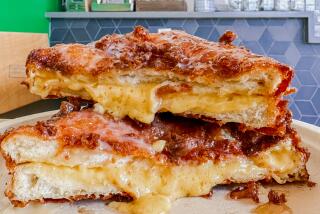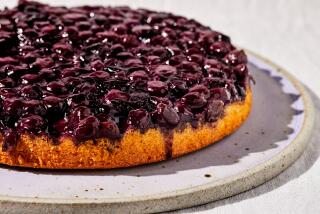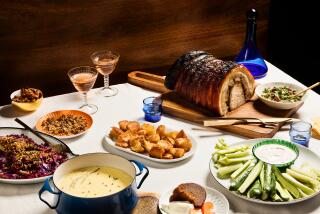It’s a Cake! It’s a Pudding! It’s Sorta Magic!
- Share via
There’s not a lot to it: eggs, milk, sugar, lemons and a little bit of flour. That’s probably one reason sponge puddings were once such a popular homey dessert.
Of course, you can’t underestimate the importance of the magic factor either.
You can imagine those bygone days, long before cable--heck, even before TV: The cook whips up this thin batter and folds in egg whites, then the whole thing is put in the oven and, half an hour or so later, out come two desserts in the same pan! A puffy, light cake on top and a creamy pudding underneath.
Well, as I said, this was before cable. Today, we can look at a sponge pudding--they were also called pudding cakes--with a lot less wonder. Cook any liquid with egg whites in it and those egg whites will float together into a raft, pulling with them all of the undissolved solids in the liquid. That’s how a consomme is clarified.
In this case, instead of assorted meaty muck, the whites pull up the flour and just enough sugar to make the cake part faintly sweet. Down below, the combined egg yolks, lemon juice and sugar bake into a kind of loose lemon curd.
Figuring it out, though, does nothing to diminish the dish’s essential appeal. This is one of those delicate, ladylike desserts that you can easily imagine some Victorian hostess serving to her guests. The flavors aren’t bold enough to scare anyone, and there is something quite soothing about the whole thing.
Stephen Schmidt, who is writing a book on historical American desserts, says the earliest trace he has found of this recipe was in the 1847 “The Carolina Housewife” by Sara Rutledge. In this version, instead of lemon, the pudding is flavored with rose water. There is also a very proper sponge pudding in Mrs. Lincoln’s “The Boston Cookbook,” published in 1884, that is flavored with nothing at all.
I tried half a dozen or so versions to come up with my own. Although sponge puddings can be made with many flavorings, lemon and orange have come to be the classics. Most of the variety, in fact, comes from the techniques with which they are put together, rather than from the ingredients themselves.
The first one I made was from Helen Evans Brown’s “West Coast Cookbook” (Little, Brown, 1952), normally a very reliable source. In this case, it wasn’t. In the first place, she has you cream together flour and butter to start the recipe. Since flour won’t dissolve into the butter, this makes for a very bad beginning. The result was OK, but the cake was a little gritty.
The recipe (actually listed as a pie filling, which is a fairly common use for it) from the 1953 “Joy of Cooking” (Bobbs Merrill) has you grate lemon peel with sugar and then cream it with butter before adding egg yolks, bread flour, milk and lemon juice. It has a very pronounced egg flavor in the cake part, which is much denser than the others.
In the recipe from “James Beard’s American Cookery” (Little, Brown, 1972), you beat the egg yolks together with the dry ingredients before adding the rest of the wet ingredients. Oddly, because it has more butter as well, it tastes a little less sweet than the others.
Three different techniques, each cumbersome in its own way, with pretty much the same result. Which was right? Do you mix the butter with the flour, the butter with the sugar, or the eggs with the dry ingredients?
Finally, I tried the one from the late Richard Sax’s “Classic Home Desserts” (Chapters, 1994). At last, a technique that made sense. He does away with all the complication, simply mixing the wet and dry ingredients separately, then combining them into a loose batter. Finally, he folds in the egg whites. The whole thing takes about 5 minutes, and the result is every bit as good as the others.
Having neatly done away with a century of fuss, I turned to perfecting the ingredient list. Because most of the recipes were quite close, it was mostly a matter of fine-tuning. I used the lower amount of sugar and combined it with the melted butter, as in the Beard. I increased the amount of lemon juice and lemon rind (we aren’t quite as sensitive as our forebears). Finally, I reduced the egg whites by one. I like a dessert that is a little more pudding than cake.
When you think about all the trouble cooks have been going through over the years in putting this thing together, maybe the real miracle is that it didn’t vanish years ago. On the other hand, maybe that’s more a testament to its virtues.
LEMON SPONGE PUDDING
No matter how tempted you might be, don’t try this without the water bath. The direct heat will scramble the eggs.
3 tablespoons flour
3/4 cup sugar
1/4 teaspoon salt
1 cup milk
3 egg yolks
6 tablespoons lemon juice
2 tablespoons grated lemon zest
1 tablespoon melted butter
2 egg whites
Stir together flour, sugar and salt in small bowl.
Stir to blend milk, egg yolks, lemon juice and lemon zest in large bowl. Add dry ingredients to wet ingredients and stir together to form smooth, liquid batter. Stir in melted butter.
Beat egg whites until stiff but not dry. Add egg whites to batter and gently but thoroughly fold together.
Pour batter into buttered 2-cup mold. Place large baking dish in 350-degree oven and place filled mold in dish. Add hot water to 1 inch up side of baking dish. Bake until top is set and well-browned, about 40 minutes. Serve hot or room temperature.
6 servings. Each serving:
175 calories; 159 mg sodium; 79 mg cholesterol; 4 grams fat; 31 grams carbohydrates; 4 grams protein; 0.01 gram fiber.
More to Read
Eat your way across L.A.
Get our weekly Tasting Notes newsletter for reviews, news and more.
You may occasionally receive promotional content from the Los Angeles Times.











